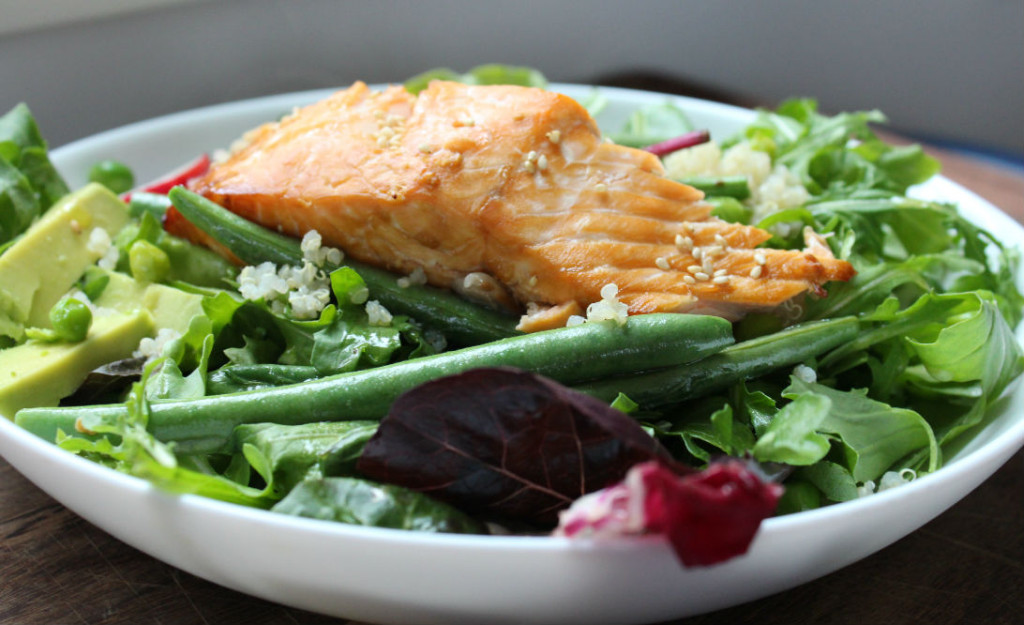We eat salmon on a weekly basis, mostly for the health benefits but also for the taste. I am lucky both girls and D love salmon too. This salmon salad is made with seasonal ingredients like arugula, radishes, and spring peas but you can substitute any vegetables to suit your taste preferences. I made a simple but flavourful dressing to go along with this spring salad.
Salmon has many health benefits such as heart health, bone health, and anti inflammatory properties. Salmon is an excellent source of essential omega 3 fatty acids, decosahexenoic acid (DHA) and eicosapentaenic acid (EPA ). Omega 3 fatty acids which aid in reducing inflammation and risk of blood clots. Due to its high DHA content, salmon also plays an important role in brain development in babies.
We buy salmon and seafood that is both fresh and sustainable. However, buying sustainable fresh seafood can be confusing for consumers with misleading messages and advertising. An important point to remember is not all farmed fish are created equal. A good way to tell if your seafood is sustainable is took for the ocean wise symbol.
Ocean Wise, developed by the Vancouver Aquarium, is a program developed to help consumers make informed choices when it comes to buying and eating seafood. According to Ocean Wise, sustainable seafood’s defined as marine life that has been caught or farmed to preserve the long term health of marine life and the ecosystem.
Ocean Wise has two classifications sustainable and unsustainable. The species are classified based on recent scientific research and are updated regularly. The program lists different issues that affect our marine life.
1). Overfishing
In order to keep up with increase in demand overfishing plays the greatest threat to our oceans. It is estimated that 90 percent of large predatory fish are extinct.
2). Bycatch (unintended)
Approximately 40 percent of marine life that are captures are discarded because of low demand, small in size and or endangered species.
3). Habitat damage
Some farming and fishing practices negatively impact the marine life, making it difficult for them to survive or thrive in certain conditions.
Closed Captivity: (Sustainable)
Fish are raised in land based tanks that are closed. The goal is to create a natural eco like system for the fish.
Reduce spread of disease to wild fish, decreasing outbreaks.
Reduced exposure to heavy metals like mercury.
No use of antibiotics or growth hormones.
Fish are fed organic feed only.
Ocean Wise approved.
Open net cage fishing: (Unsustainable)
Involves a large floating net the size of approximately two football fields that can hold unto a million fish at a time.
Most common and controversial farm fishing method.
Over populated with fish, leaving them at risk for damaged fins and disease, leaving the conditions unsanitary.
Fish are fed pellets containing GMO’s, animal by products, grains, and soy. Many fish are overfed to increase growth faster.
Antibiotics and pesticides are commonly used to keep marine life healthy.
3 Tips for buying sustainable seafood
1). Ask questions
Ask your fish supplier about where their food comes from and how it is farmed and fed. Good fish markets in the lower mainland include:
2). Look for Ocean Wise
When buying seafood look for seafood that has the Ocean Wise logo. Ocean Wise works with restaurants, markets, and producers to ensure sustainable farming practices are maintained to ensure quality and clean oceans.
3) Eat a variety
When buying seafood choosing a variety of different seafood like salmon, halibut, sole, trout, sablefish, mussels and lobster to reap the health benefits and improve the ocean’s eco-system.
Zest Nutrition
Yields 2
20 minPrep Time
10 minCook Time
30 minTotal Time
Ingredients
- Salad
- 1 6 oz salmon fillet
- 2 cups of arugula, washed and chopped
- 2 cups of mixed greens, washed and chopped
- 6 radish, washed and thinly sliced
- 1 cup of green beans, washed and trimmed
- 1 cup of spring beans
- 1/2 avocado
- teriyaki marinate
- 1/2 cup of low sodium soy sauce
- 2 TBSP honey
- 2 TBSP rice vinegar
- 1/4 cup of water
- 2 gloves of garlic, crushed
- 1 TBSP fresh ginger
- Salad dressing
- 2tbsp extra virgin olive oil
- 1 tbsp white wine vinegar
- 1 tsp dijon mustard
- 1 tsp honey
- salt and pepper to taste
Instructions
- ). Preheat oven to 375 degrees
- ). Wisk together all marinate ingredients
- ). Marinate salmon for at least 30 minutes
- ). Cook quinoa as per directions of box
- ). In a small skillet heat olive oil and sauté green beans for 2-3 minutes, slightly cooks with crispness. Season with salt and pepper
- ). Combine salad greens, arugula, avocado, radish, peas, and beans. Toss lightly with dressing
Enjoy!



 Save Recipe
Save Recipe
No comments yet.